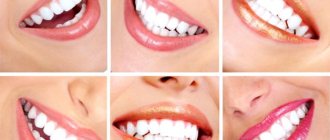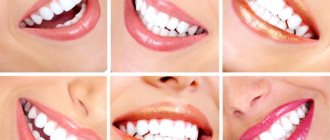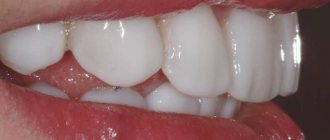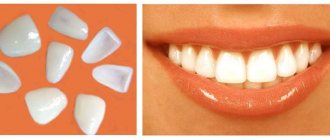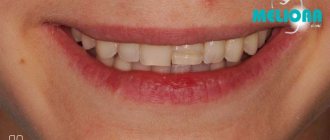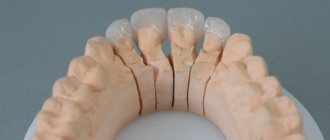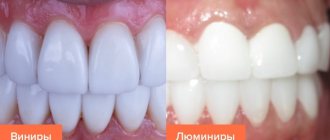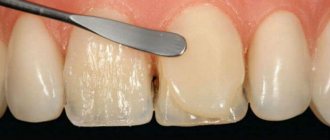Aesthetic (artistic) dental restoration
Artistic or aesthetic dental restoration is the reconstruction of a damaged tooth using composite materials. This treatment is carried out by a dentist-therapist specializing in aesthetic restoration.
To restore one tooth in the smile area (reason: chipped cutting edge, caries), the same composite light-curing materials are used as for filling. The tooth is restored by layer-by-layer application of materials. This technology makes it possible to almost completely reproduce natural enamel in color, transparency and strength.
Installation of high-quality veneers by our experienced orthopedists:
- veneers with minimal tooth
- installation of high-quality veneers that are invisible to others , observing all anatomical features
- Patients do not have problems with TMJ because the orthopedist works in tandem with a gnathologist
- ready-made veneers are already on the teeth in just 2 visits
- veneers with a service life of 20 years or more
- extended warranty
- detailed treatment plan with no hidden fees
- quality treatment at prices in the residential area of Yasenevo
Dental restoration with inlays
If the tooth is severely damaged and most of the crown part is missing, the doctor will suggest restoration using a ceramic inlay. Inlays are created in a dental laboratory using an individual impression. These microprostheses are distinguished by the highest aesthetics and durability.
Advantages of inlays compared to conventional fillings:
- high resistance to external factors (do not change color even from drinking coffee);
- translucency, maximally imitating natural enamel;
- perfect shape, repeating in detail all the features of the destroyed part of the tooth;
- the possibility of shrinkage, which provokes the occurrence of hidden caries, is excluded.
What are veneers?
A ceramic veneer is a thin ceramic plate-onlay on a tooth that can restore a damaged tooth and improve the aesthetic properties of the tooth, namely color, shape, size. Ceramic veneer is new, durable tooth enamel. Durable enamel with minimal grinding, no harm to teeth in just 14 days.
There are two types of ceramic veneers: porcelain and zirconia. As a result of installing the first option, you get the famous “Hollywood smile”. They are well fixed on the teeth, their main task is to improve their aesthetic appearance. The downside is that they cannot withstand heavy loads.
Zirconium dioxide consists of a zirconium frame on which a ceramic mass is applied. In terms of their strength characteristics, they are significantly higher than porcelain ones, but at the same time their fixation on the teeth is less reliable.
The process of installing veneers includes several stages. First, the top layer of enamel is ground off and temporary plastic onlays are attached to the teeth. This is necessary to protect teeth from negative external factors. Once the veneers are made in the desired color, they are attached to the surface of the tooth with special dental cement. To enhance the adhesion force, a special etching gel is applied before this.
Caring for veneers is almost no different from caring for natural teeth. Hygienic cleaning is also carried out twice a day. It is recommended to choose a brush with medium-hard or soft bristles. You should use toothpaste with a minimum amount of abrasives in order to expose the ceramic surface to mechanical damage as little as possible. Additionally, you can use an irrigator. It delivers a stream of water under pressure, which allows you to remove plaque and food debris more effectively.
You need to visit the dentist several times a year. A specialist must monitor the condition of veneers, teeth and gums. If you experience the slightest discomfort, roughness or gap at the junction of the veneer with the gum, you should immediately contact a dental clinic. If you delay this issue, bacteria may accumulate in the resulting damage, which will have a negative impact on the condition of your teeth and gums.
If used properly, veneers can last up to 25 years. The service life also largely depends on the material and on the competence of the specialist who installed them. They can also be negatively affected by mechanical injuries and regular exposure to low and high temperatures, so you should be careful when drinking hot or cold drinks. If all the above conditions are met, veneers will retain their aesthetic and quality characteristics for many years.
Professional hygiene and whitening
Modern aesthetic dentistry is unthinkable without professional dental hygiene. This procedure gets rid of plaque and tartar, returns the enamel to its natural shade, strengthening it, and is also an excellent prevention of caries.
Whitening is also an important aspect of aesthetic dentistry. Modern in-office whitening techniques (when the procedure takes place in the dentist’s office) make it possible to restore the whiteness of your smile in one session. The doctor may also suggest one of the home whitening systems.
Indications for use
To better understand what composite veneers are, the indications for their use will help. They are the same as ceramic veneers. The main indication is artificial restoration of enamel.
Dentists claim that they prepare such veneers for patients with signs of defective enamel: hypoplasia, aplasia, fluorosis, necrosis, tetracycline teeth.
These diseases can lead to complete destruction of the enamel. This results in an unhealthy color and an unaesthetic smile.
Direct composite veneers are used to hide or reduce the space between teeth (front teeth only). This will help hide unevenness and chips in the enamel. It is important to consider that this application will be relevant for correcting 1-2 teeth.
For more global problems, a different technique is used. Used in such cases:
- A chipped or sharp edge of a tooth.
- The space between the front teeth.
- The size does not match the shape of the plates.
- Injuries, as a result, changed their shape.
- Yellow or dark stains that are not removed by the bleaching process.
- Wedge defect.
- Premature aging and wear of enamel.
- Various pathological processes in periodontal tissues.
The technology for using composite veneers has been around for a long time. There is a wide range of veneers. They come in different strengths, wear life and colors. Their cost depends on this. This is also influenced by the technology of the procedure and the global extent of dental damage.
Direct veneers are universal and simultaneously solve all the problems mentioned above. You can install them in one go. It is worth noting that this procedure is not suitable for everyone and has certain contraindications. The main ones include:
- Global enamel defects not caused by caries. The classification is carried out taking into account the time of their formation. The first category is the period of pregnancy, the first teeth in children. The second category is the period when teeth begin to emerge.
- Loose teeth . This is one of the types of periodontal disease, which is accompanied by severe inflammation of bone tissue. This disease is treatable. Before installing veneers, the doctor prescribes periodontal treatment.
- Excessively weft enamel . It occurs against the background of bad habits (smoking), high consumption of sugar, and unhealthy diet. May have a genetic nature and individual characteristics.
- Rapid wear of teeth . This leads to the deformation of the crown shape.
- Bruxism . A disease that is accompanied by teeth grinding. This usually occurs during sleep. The patient must use a special dental guard. Otherwise, tooth damage and enamel wear occurs.
- Malocclusions.
- Caries.
Not all of these contraindications are categorical for the use of composite veneers. The patient undergoes a consultation with a dentist, who determines the treatment and the possibility of installing a veneer.
The techniques that doctors use in such cases are varied. Direct veneers have the advantage of not requiring complex manipulations . First of all, they don’t take impressions of your teeth. This saves time because the patient does not have to wait for the plate to be prepared.
Secondly, the installation of the veneer is carried out in 1 appointment. The procedure does not harm healthy teeth. Also, no anesthesia or dental glue is used.
It is worth noting that installing composite veneers is quite difficult. We can say that this is jewelry work. The doctor who performs it must have extensive experience. The patient does not experience pain or discomfort during the procedure. You can get a beautiful smile in just 1-1.5 hours.
Veneers can be removed at any time or corrections can be made. The procedure is carried out quickly and painlessly. Therefore, the patient should not be afraid to go to the dentist.
Disadvantages of using veneers
Each treatment procedure has advantages and disadvantages. Veneers are a safe and, in some cases, irreplaceable procedure. The use of direct composite veneers is safe. Despite this, there is a list of disadvantages to using this technique. These include:
- Carrying out veneer placement requires speed. The doctor has a limited time when installing a direct veneer, since it occurs in the oral cavity.
Ceramic ones are made by a technician using simulated teeth. Two doctors are involved in this process. They have more time and can make high-quality and beautiful veneers.
- Direct composite veneers wear out faster than ceramic veneers.
- Photopolymer veneers do not have a natural surface shine.
- Low strength.
- Large thickness of photopolymer veneers.
The disadvantage of a composite veneer depends on the quality of its material and the doctor’s determination. There are many more benefits. There are no other quick and effective ways to restore tooth enamel.
In addition, this technique is safe and does not require anesthesia or painkillers. This is very important, because many patients suffer from allergies to anesthesia.
Using direct composite veneer is completely safe. This is an excellent solution for people with damaged front teeth. Against this background, various complexes often develop. Once installed, the person receives a beautiful, natural smile.
How does the installation work?
Before you start working with veneers, you need to understand exactly how they are installed. Understanding the entire procedure allows you to tune in to it in advance, as well as promptly pay attention to violations. Our dentists always explain exactly what they do and why. If something is unclear to you, clarify: they will answer you.
The procedure is carried out in different ways, since much is individual. The process is influenced by the condition of the oral cavity, the material used, and the features of a particular design. You also need to take into account what exactly was done before going to the dentist, whether there was any treatment, and if so, what kind of treatment. At the DentBerg clinic, all this is necessarily taken into account.
Typically, veneers are installed as follows:
- First an inspection is carried out.
- If everything is in order, an impression is made.
- The teeth are prepared for the installation of veneers. In more cases they are sharpened. If desired, you can ask for anesthesia, since the procedure itself sometimes causes discomfort.
- Temporary veneers are installed.
- Overlays are being made.
- During the second visit, permanent veneers are fixed, which takes about 4-6 hours.
- The doctor polishes the pads and removes any remaining fixing agent.
Adaptation after installation takes on average several days. If discomfort persists for longer, you should consult a doctor.
Is it painful to install veneers on your front teeth?
Many patients are concerned about possible pain during the installation of veneers. In reality, such a nuisance does occur, but it is extremely rare. Veneers are fixed exclusively to healthy teeth, which every self-respecting dentist checks separately. Therefore, there will be no pain.
But due to the individual sensitivity of the gums and teeth, discomfort is possible. To avoid such sensations, you should use appropriate toothpaste for 3-4 weeks before installing veneers. This formulation is specifically designed to reduce sensitivity. It is best to select it with a dentist.
And one more thing: if you are afraid of discomfort or have a low pain threshold, ask your dentist to use local anesthesia. Doctors do not want to intentionally cause discomfort, so in most cases they are willing to accommodate.
Prices
| Consultation | |
| Initial dental consultation and treatment plan | 500 rub. |
| Veneers | |
| Composite restoration veneer “Esthet-X” | from 8,500 rub. |
| Ceramic veneer EMAKH | from 25,000 19,900 rub. |
| Temporary veneers | 3,500 rub. |
| Diagnostics | |
| X-ray (sight) image of teeth | 400 rub. |
| Panoramic photograph of teeth (orthopantomogram) | 1,000 rub. |
| Anesthesia | |
| Infiltration anesthesia | 500 rub. |
| Conduction anesthesia | 600 rub. |
Contraindications for installing veneers
Such dental restoration is not possible in all cases. It is prohibited to carry out if there is:
- malocclusion;
- bruxism;
- mental disorders;
- defects of hard dental tissues;
- incorrect position of teeth (uneven teeth) and malocclusion;
- failure to comply with hygiene rules;
- presence of crowns;
- congenital pathologies;
- periodontal diseases;
- genetic predisposition to various diseases in the oral cavity;
- individual characteristics of teeth.
Promotions of the DentBerg clinic
Ceramic veneer
Promotion for installation of E-Max ceramic veneer at the DentBerg clinic.
25,000 19,900 rub. More details
the promotion is valid until 12/31/2021
5% discount on dental prosthetics for pensioners
Get a 5% discount on dental prosthetics at the DentBerg clinic.
More details
the promotion is valid until 12/31/2021
Refractor in dentistry - what is it?
In the usual production of veneers, doctors first create a wax model of the teeth, and then dental technicians use pressing or milling to create a solid veneer, the front surface of which imitates natural tooth enamel.
When using a refractor, a refractory base is first formed from a special material, and the dental technician applies ceramics to it in layers, forming a very thin plate. Then the entire structure is baked in an oven, after which it is handed over to the doctor so that the patient can try on the resulting veneer.
So, when answering the question “refractor veneers - what are they?” we can say that this is a very thin plate, in addition to the front surface of the tooth, slightly covering the side edges and the cutting edge. In fact, it is frameless and metal-free ceramics, the strength of which is imparted by a fire-resistant base.
Differences between veneers created using a refractor and conventional ones:
- strengthening teeth - after installation, the refractor plates are tightly connected to the surface of the tooth, which makes the structure very strong, almost monolithic, in contrast to pressed or milled plates, which remain rigid and non-plastic;
- increased strength - they are almost not susceptible to chipping or other damage, even if you like very hard food;
- minimal grinding due to minimal thickness - and sometimes you can even do without tooth preparation. Some clinics claim that they can make a ceramic veneer on a refractor with a thickness of 0.1–0.2 millimeters;
- almost no preparation is required - often it is enough to treat the enamel with a special compound and fix the veneers.
Proper care
Once installed, composite or other veneers require careful care. You cannot bite hard food, limit traumatic effects and the influence of external factors. It is forbidden to bite foreign objects.
The patient must take good care of his teeth. Use toothbrushes, floss and irrigators. In addition, veneers need polishing. This procedure is performed by a dentist. Once every six months you need to undergo a doctor’s examination and, if necessary, make corrections to the composite veneer. With proper care, the service life of the linings will be long.
